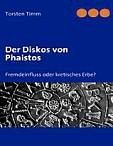| deutsche Version |
  |
The only safe course at present is to proceed |
The Phaistos Disc |
|
The "Phaistos Disc" (or Phaestos disk, Festos disk) can be admired as one of the most impressive artefacts in the archaeological museum in Heraklion. Its creator stamped hieroglyphic-type characters arranged in a spiral shape onto a round clay tablet. The life-like signs represent people, animals and plants. The fascination of the Phaistos Disc does not only arise from the one-off creation of the artefact but in particular from the fact that it still has not been possible to decipher it. The characters on both sides of the clay tablet have given rise repeatedly to numerous, very different and frequently mutually exclusive theories; however, hitherto, no academic has been able to wrench the secret from the Phaistos Disc. It is therefore one of the unsolved mysteries of the Aegean civilisations. The academic consensus about the insolubility of the "Phaistos Disc mystery" cannot stop the search for answers to the numerous unanswered questions: What were the stages of work in which the Phaistos Disc was made? Where does the text start? Who stamped the Phaistos Disc and for what reason? Which type of script and which language is reflected in the text? Do other scripts used in the Aegean during the Bronze Age provide access to the text, for example, the linear scripts or the Cretan hieroglyphic script? Despite the brevity of the script, a comparison of both sides of the Phaistos Disc based on structural analysis provides evidence of interesting regularities. These are described and discussed in the study "Der Diskos von Phaistos - Fremdeinfluss oder kretisches Erbe? (The Phaistos Disc)" against the background of previous investigations and interpretations. Even if serious researchers into the artefact agree that to decipher the "Phaistos Disc" it is necessary to have others texts of the same script type, earlier attempts have been continued to consider solving the mystery in a systematic way. First of all the following are discussed: the controversial questions of the academic dispute about script type, reading direction and the front side of the Phaistos Disc. On the basis of these answers the attempt is made to examine previous suggestions with regard to deciphering the Phaistos Disc in a critical way and to outline possible new initiatives in the search for a solution. In particular the following are used as a factual basis: the structural analysis of the Phaistos Disc text of Ipsen, Godart and Muenzer's comprehensive discussion of the characters, the ideas of Grumach, Nahm, Duhoux and Sornig as well as Neumann's critical evaluation of previous attempts at interpretation. The attempt to answer at least some of the above unanswered questions and the examination of both sides of the Phaistos Disc based on mathematical methods of analysis open up the possibility of comparing the text with other scripts. The comparison with the linear scripts indicates that hardly any similarities with Linear B can be proved. However, numerous parallels with Linear A can be found. This "affinity" enables the assumption to be made that the Phaistos Disc script is a stamp script in conformity with Linear A. In addition, interpretation of the Phaistos Disc as a product of Minoan culture is supported by the location where the Phaistos Disc was found and the scientific determination of age based on the circumstances surrounding the find. The detailed research with the title "Der Diskos von Phaistos - Fremdeinfluss oder kretisches Erbe?" was published in 2005 (2nd edition Sep 2008). Questions, comments or suggestions about the outlined object of investigation are welcomed. Please email me if you have any. Dresden, Sep 2008
Torsten Timm |
| Back to top |
|
© 2003-19 by Torsten Timm | |